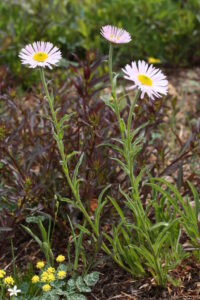 You have to love a plant that comes with the following catalog description: “possesses enough brawn to easily tackle heat, humidity, dry shade and lean soil, yet detests too much fertility.”
You have to love a plant that comes with the following catalog description: “possesses enough brawn to easily tackle heat, humidity, dry shade and lean soil, yet detests too much fertility.”
That describes my climate and parts of my garden perfectly. The good news is that the plant in question is already growing there, having found its way in via birds, bees or windblown seeds. Its Latin name is “erigeron” and the common name of the most frequently-seen erigeron species is “daisy fleabane”.
Daisy fleabane looks very much like an aster, but blooms earlier—in spring and early summer. It is part of the vast Compositae or daisy family, and the resemblance to its daisy relatives is obvious. Rising on slightly fuzzy stems up to three feet tall—but often shorter depending on species and growing conditions—the plants are topped by one-inch daisies with relatively large golden centers surrounded by numerous slender white, pinkish or light purple petals or rays. In the philadelphicus species, which is native throughout the United States and Canada, plants have rosettes of basal leaves, with additional leaves diminishing in number as they sprout farther up the stalks. Another native erigeron, pulchellus, that grows wild in the eastern part of North America, is a little shorter, with the same stalk and leaf configuration, but palest violet rays.
Fleabanes are not elegant plants, and, in fact, some garden snobs are likely to call them “weedy”. When I first saw them popping up here, there and everywhere in my garden, I regarded them as a nuisance. My ideas changed because my daughter, who was young at the time, loved them, and picked them for bouquets. I let them stay—grudgingly. Over time, though, I began to see the beauty of daisy fleabane. That was a positive development, since the plants had clearly taken a liking to my landscape.
Now, with the trend towards native and pollinator plants, the erigerons are having a moment in the sun. Erigeron karvinskianus, which hails from Mexico and Central America, is now in the most fashionable gardens here and in Europe. A little shorter than some of its relatives, at only 12 to 15 inches tall and wide, the species boasts daisies that may be white or tinged with pink or pale lavender. In England, karvinskianus is so popular and hardy that it won the Royal Horticultural Society’s prestigious Award of Garden Merit or AGM.
The Latin genus name, erigeron, is an amalgamation of two Greek root words—“eri”, for its early bloom and “geron”, signifying that the stems are fuzzy like an elderly man’s beard. The same root gives us other words that signify old age, like “geriatric” and “gerontologist”. The common name, “fleabane” harkens back to when decoctions of erigeron plant parts were used as a flea dip for animals or a flea repellant for humans. This may be the reason why deer and other garden varmints shy away from the fleabanes.
Erigerons are excellent self-seeders, and if you plant them once, you are likely to see them again in subsequent years. Like columbines, herb Robert, and similar plants, they will come up in sidewalk cracks and wall fissures just as readily as they spring out of garden beds. I think this is a charming habit, but the plants are also fairly shallow-rooted and easy to pull out if they show up as unwanted guests in otherwise plant-free locations.
The erigerons in my garden seem to appear in small groups of three or four plants, but some species, like karvinskianus, are prone to forming what botanist Martin Rix describes as “billowing colonies.”
Pollinators flock to fleabanes, as they do to most of the daisies. The plants are natural fits for cottage gardens, naturalized areas and semi-shaded locations, and can also be grown successfully in containers. Well-drained soil is a must, and once the plants are established, they are quite drought tolerant. Like supermodels, they live on a lean diet, so there is no need to fertilize plants growing in-ground. Fertilize container specimens extremely sparingly, if at all.
Sometimes larger garden centers and nurseries carry erigerons, especially karvinskianus. If you can’t find any nearby, try Digging Dog Nursery, 31101 Middle Ridge Road, Albion, CA 95410; (707) 937-1130; www.diggingdog.com. Print catalog available.
